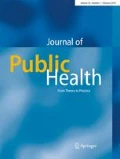Abstract
The physical environment has emerged as a potential correlate to physical activity, and altering the environment could be one way to increase physical activity on a population level. The aim of the present study was to assess the test–retest reliability of the Swedish version of an environmental instrument developed for population-based studies. The study population was recruited from a larger study performed at the same time. A random sample of Swedish adults, age 18–74, was invited to participate in the reliability testing of 17 questions regarding the local physical environment. The questions addressed variables such as presence of sidewalks, bike paths and recreational facilities as well as questions regarding aesthetic, social and safety attributes. A total of 98 subjects completed the test and retest questionnaires. Overall percent agreement ranged from 55.1–92.9%. Intraclass correlation (ICC) for the total sample ranged from 0.36–0.98. The questions regarding motorized vehicles produced the highest total reliability score (ICC=0.98) and the question regarding safety from crime during the day produced the lowest (ICC=0.36). Small differences were seen between men and women for a few variables, but no apparent pattern was identified. The test–retest of the Swedish version of the environmental module resulted in substantial agreement for most variables. The instrument showed an acceptable reliability and can therefore be used in future studies regarding local environmental attributes and physical activity in Sweden.
Similar content being viewed by others
References
Altman DG (1991) Practical statistics for medical research. Chapman & Hall, London, UK
Bauman AE, Sallis JF, Dzewaltowski DA, Owen N (2002) Toward a better understanding of the influences on physical activity, the role of determinants, correlates, casual variables, mediators, moderators and confounders. Am J Prev Med 23(2S):5–14
Brownson RC, Chang JJ, Eyler AA, Ainsworth BE, Kirtland KA, Saelens BE et al (2004a) Measuring the environment for friendliness towards physical activity: a comparison of the reliability of 3 questionnaires. Am J Public Health 94:473–483
Brownson RC, Hoehner CM, Brennan LK, Cook RA, Elliott MB, McMullen KM (2004b) Reliability of 2 instruments for auditing the environment for physical activity. J Phys Activity Health 1:191–208
Craig CL, Marshall AL, Sjöström M, Bauman AE, Booth ML, Ainsworth BE et al (2003) International Physical Activity Questionnaire: 12-country reliability and validity. Med Sci Sports Exerc 35:1381–1395
De Bourdeaudhuij I, Sallis JF, Saelens BE (2003) Environmental correlates of physical activity in a sample of Belgian adults. Am J Health Prom 18:83–92
Giles-Corti B, Donovan RJ (2002) The relative influence of individual, social and physical environment determinants of physical activity. Soc Sci Med 54:1793–1812
Handy SL, Boarnet MG, Ewing R, Killingsworth RE (2002) How the built environment affects physical activity, views from urban planning. Am J Prev Med 23:64–73
Humpel N, Owen N, Leslie E (2002) Environmental factors associated with adults’ participation in physical activity, a review. Am J Prev Med 22:188–199
Kirtland KA, Porter DE, Addy CL, Neet MJ, Williams JE, Sharpe PA et al (2003) Environmental measures of physical activity supports, perceptions versus reality. Am J Prev Med 24:323–328
Owen N, Humpel N, Leslie E, Bauman A, Sallis JF (2004) Understanding environmental influences on walking, review and research agenda. Am J Prev Med 27:67–76
Saelens BE, Sallis JF, Black JB, Chen D (2003) Neighborhood-based differences in physical activity: an environment scale evaluation. Am J Public Health 93:1552–1558
Sallis JF, Owen N (1999) Physical activity and behavioral medicine. Sage, Thousand Oaks, CA
Troped PJ, Saunders RP, Pate RR, Reininger B, Addy CL (2003) Correlates of recreational and transportation physical activity among adults in a New England community. Prev Med 37:304–310
Trost SG, Owen N, Bauman AE, Sallis JF, Brown W (2002) Correlates of adults’ participation in physical activity: review and update. Med Sci Sports Exerc 34:1996–2001
Welk GJ (2002) Physical activity assessments for health related research. Human Kinetics, Champaign, IL
Wendel-Vos GCW, Schuit AJ, De Niet R, Boshuizen HC, Saris WHM, Kromhout D (2004) Factors of the physical environment associated with walking and bicycling. Med Sci Sport Exerc 36:725–730
Author information
Authors and Affiliations
Corresponding author
Rights and permissions
About this article
Cite this article
Alexander, A., Bergman, P., Hagströmer, M. et al. IPAQ environmental module; reliability testing. J Public Health 14, 76–80 (2006). https://doi.org/10.1007/s10389-005-0016-2
Received:
Accepted:
Published:
Issue Date:
DOI: https://doi.org/10.1007/s10389-005-0016-2


